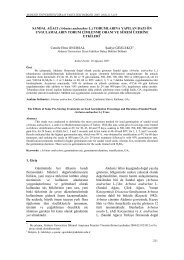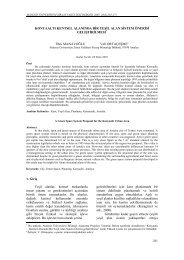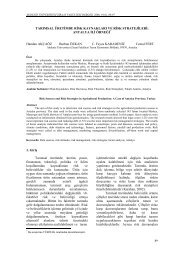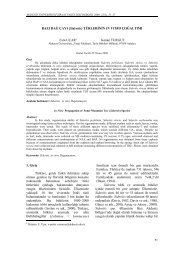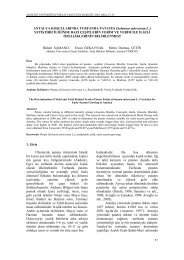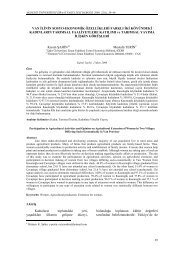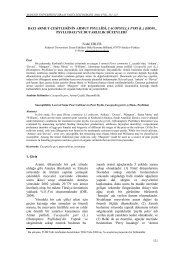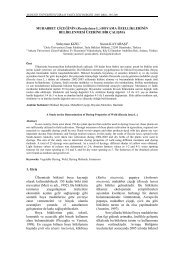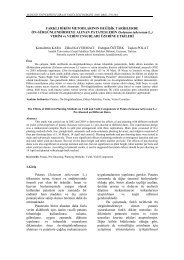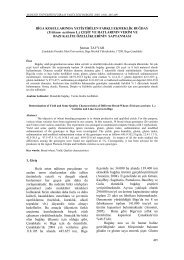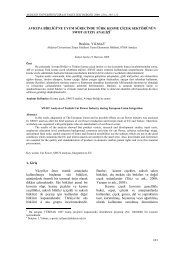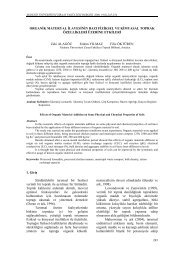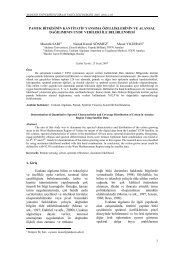CHLOROPLAST matK GENE PHYLOGENY OF ... - ResearchGate
CHLOROPLAST matK GENE PHYLOGENY OF ... - ResearchGate
CHLOROPLAST matK GENE PHYLOGENY OF ... - ResearchGate
You also want an ePaper? Increase the reach of your titles
YUMPU automatically turns print PDFs into web optimized ePapers that Google loves.
Chloroplast <strong>matK</strong> Gene Phylogeny of Some Important Species of Plants1. IntroductionRecent advances in DNA sequencingtechnologies and molecular biology enableus to characterize genomes of organismsand now many ongoing genome projects forvarious species are providing valuableinsights into their biology and utilizations.The application of molecular biologyinformation to systematic and evolution hasresulted in significant contributions to plantsystematics and in the emergence ofmolecular systematics as a solidinterdisciplinary field (Mort et al., 2001).Nucleotide sequence variability inchloroplast DNA (cpDNA or plastid DNA)at inter-(between families or genus) andintra-specific level (within species orvarieties) has been surveyed primarily inorder to analyze the phylogeneticrelationships and plant identification studies(Tamura et al., 2004).The <strong>matK</strong> gene, a chloroplastgenome encoded locus located within theintron of the chloroplast gene trnK, encodesa maturase on the large single-copy sectionadjacent to the inverted repeat of everyplant families, has high rates of substitutioncompared to other chloroplast genes and itsDNA sequence is one of the least conservedplastid genes; therefore, has beeneffectively used in plant evolution andaddresses the phylogenetic questions invarious taxonomic levels (Ito et al., 1999;Fuse and Tamura, 2000).The <strong>matK</strong> gene has severaladvantages in comparison to other genesincluding the organelle genome genes. Firstof all the <strong>matK</strong> gene evolves approximatelythree times faster than the widely usedplastid genes rbcL and atpB. It is in thechloroplast genome and in many cases it ismaternally inherited. This gene has areasonable size, high rate of substitution,large proportion of variation at the first andthe second codon positions, low transitiontransversionratio, and the presence ofmutationally conserved sectors. Researchhas shown that the variations at nucleic acid(DNA) and amino acid levels evenlydistributed throughout the entire gene, andthe 5’ region of the <strong>matK</strong> gene appears tohave more variation than the 3’ region inmany monocotyledons and dicotyledons.Because of these unique characteristics,<strong>matK</strong> gene sequences (at both nucleic acidsand amino acid sequence levels) have beenused successfully to resolve family andeven species level relationships (Steele andVigalys, 1994; Brochmann et al., 1998;Koch et al., 2001; Tamura et al., 2004).In this article, we report the results ofphylogenetic analyses of chloroplast <strong>matK</strong>gene sequences from 142 plant speciesbelong to families of 26 plants and 22orders. Relationships within and betweenmonocotyledons, dicotyledons andgymnosperms were discussed. Thisinformation may facilitate the utilization ofthe genetic resource in wild germplasm andprovide an important basis for addressingthe many intriguing questions involving thebiogeography and genome evolution studies.Also determined genetic relationships mayprovide valuable information for bothconventional and modern plant breedingstudies.2. Material and MethodsA total of 142 <strong>matK</strong> sequences weredownloaded from GenBank database(http://www.ncbi.nlm.nih.gov/Genbank/index.html). These <strong>matK</strong> DNA sequences werethen aligned using the Clustal W program(Thompson et al., 1994). Result of thealignments showed that there were variablenumbers of indels in <strong>matK</strong> gene. All gapcharacters were scored as missing datarather than a fifth character. Sequencesranging from 730 to 1545 bp in lengthprovided a data set of 2089 bp afteralignment.Phylogenetic analyses of thesequence data were conducted using theparsimony method using Petroselinumcrispum <strong>matK</strong> DNA sequence as reference.The sequence data were also analyzed witha neighbor-joining (NJ) and UnweightedPair Group Mean Average UPGMAmethods as implemented in PAUP* 4.0(Swofford, 2002). The level of support forbranches of the phylogenetic trees wasevaluated with the bootstrap analysis(Felsenstein, 1985) to verify the length of158



